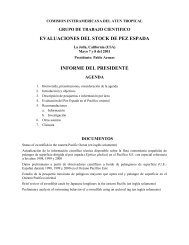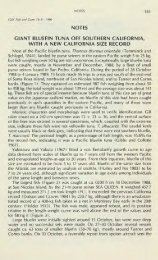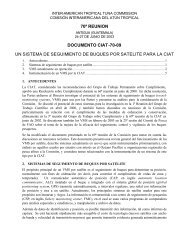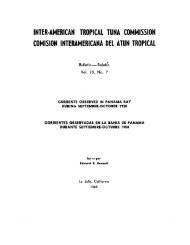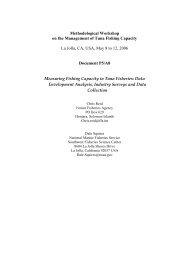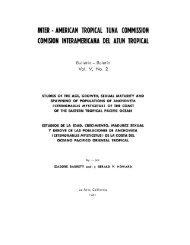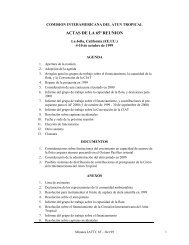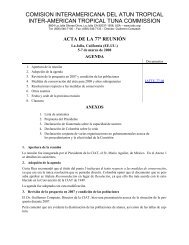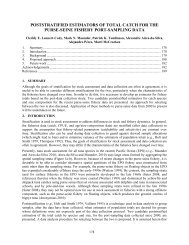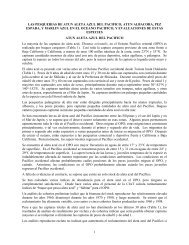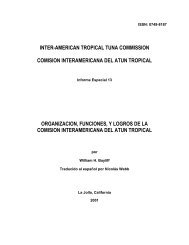Informe Anual de la Comisión Interamericana del Atún Tropical, 19
Informe Anual de la Comisión Interamericana del Atún Tropical, 19
Informe Anual de la Comisión Interamericana del Atún Tropical, 19
Create successful ePaper yourself
Turn your PDF publications into a flip-book with our unique Google optimized e-Paper software.
ANNUAL REPORT <strong>19</strong>87<br />
Tuna vessels fishing in the EPa occasionally fish in other areas in the same year. In <strong>19</strong>87 sorne<br />
vessels which were part of the EPa fleet also fished in the western Pacific or in the At<strong>la</strong>ntic and<br />
Caribbean. The <strong>19</strong>80-<strong>19</strong>86 average catch by these vessels in the western Pacific was about 23<br />
thousand tons (range: 6 to 84 thousand tons), and in the At<strong>la</strong>ntic and Caribbean about 11 thousand<br />
tons (3 to 17 thousand tons). The maximum catches in these areas by vessels ofthe EPa fleet were<br />
ma<strong>de</strong> in <strong>19</strong>83, the year of the lowest total catch in the EPa (181 thousand tons) since <strong>19</strong>61.<br />
Preliminary estimates indicate that the <strong>19</strong>87 total catches in these areas by vessels ofthe EPa fleet<br />
were about 6 thousand tons in the western Pacific and 6 thousand tons in the At<strong>la</strong>ntic and<br />
Caribbean.<br />
The <strong>19</strong>86 and preliminary <strong>19</strong>87 catches by f<strong>la</strong>g, and <strong>la</strong>ndings by country, oftunas in the CYRA<br />
and the EPO are given in Tables 2-5. The <strong>la</strong>ndings are fish unloa<strong>de</strong>d during a calendar year,<br />
regardless ofthe year of catch. The country of<strong>la</strong>nding is that in which the fish were unloa<strong>de</strong>d from<br />
the fishing vessel or, in the case oftransshipments, the country which received the transshipped fish.<br />
Beginning in <strong>19</strong>84 the owners ofU.S.-f<strong>la</strong>g vessels began chartering their services to companies in<br />
Ecuador and Venezue<strong>la</strong>. The <strong>19</strong>86 catches of US.-f<strong>la</strong>g vessels inelu<strong>de</strong> the catches of three vessels<br />
un<strong>de</strong>r charter to a Venezue<strong>la</strong>n company, and those for <strong>19</strong>87 inelu<strong>de</strong> the catches of one vessel un<strong>de</strong>r<br />
charter to a Venezue<strong>la</strong>n company.<br />
Yellowfin was by far the most important component ofthe total harvest in both <strong>19</strong>86 and <strong>19</strong>87,<br />
making up about 80 percent ofthe total catch ofaH species in the EPa in both years. Ofthe total <strong>19</strong>86<br />
EPa yellowfin catch of 296 thousand tons, 86 percent was harvested in the CYRA. In that year<br />
Mexican-f<strong>la</strong>g vessels took about 41 percent of the CYRA catch of yellowfin, followed by U.S.-f<strong>la</strong>g<br />
vessels wíth 28 percent; of the outsi<strong>de</strong> catch, US.-and Mexican-f<strong>la</strong>g vessels harvested 69 and 31<br />
percent, respectively. In <strong>19</strong>87 91 percent ofthe catch of305 thousand tons was ma<strong>de</strong> in the CYRA. In<br />
that year Mexican-and U.S.-f<strong>la</strong>g vessels each took about 35 percent ofthe CYRA catch; ofthe outsi<strong>de</strong><br />
catch, U.S.-and Mexican-f<strong>la</strong>g vessels harvested 52 and 43 percent, respectively. Together they<br />
accounted for about 72 percent of the total EPa catch of yellowfin; they were followed by Venezue<strong>la</strong><br />
wíth about 14 percent and Ecuador with about 6 percent ofthe EPa yellowfin catch.<br />
The tunas caught in the EPO in <strong>19</strong>86 and <strong>19</strong>87 were <strong>la</strong>n<strong>de</strong>d primarily in Ecuador, Mexico, and<br />
the United States, wíth these three nations accounting for about 75 percent ofthe <strong>la</strong>n<strong>de</strong>d fish in <strong>19</strong>86<br />
and about 83 percent in <strong>19</strong>87.<br />
During the <strong>19</strong>82-<strong>19</strong>86 period about 62 percent of the logged EPa catch of yellowfin has been<br />
taken between 5°N and WN (Tables 6 and 7). Preliminary estimates for <strong>19</strong>87 show that about 70<br />
percent of the yellowfin catch was taken in this region. The distribution of the logged purse-seine<br />
catch ofyellowfin in the eastern Pacific is shown in Figure 2. For skipjack, waters south oflOoN have<br />
provi<strong>de</strong>d about 76 percent of the logged catch during the <strong>19</strong>82-<strong>19</strong>86 period, with about 17 percent<br />
being harvested south of the equator (Tables 6 and 7). Preliminary estimates for <strong>19</strong>87 show that<br />
about 80 percent ofthe total EPO logged skipjack harvest was ma<strong>de</strong> south oflOoN, but only about 10<br />
percent ofthis was ma<strong>de</strong> south of the equator (Tables 6and 7). The distribution of the logged purseseine<br />
catch of skipjack in the eastern Pacific is shown in Figure 3.<br />
Un<strong>de</strong>r the terms of the convention which established the Inter-American <strong>Tropical</strong> Tuna<br />
Commission, monitoring ofthe condition ofthe stocks oftunas and other species taken in the eastern<br />
Pacific Ocean by tuna fisheries is the primary objective of the Commission's research. Taking into<br />
consi<strong>de</strong>ration the migrations of the tunas, the mobility of the vessels of the tuna fleets of various<br />
nations, and the international nature of the tuna tra<strong>de</strong>, statistics on the catch and effort from the<br />
eastern Pacific must be viewed in the light of global statistics. The IATTC staff routinely estimates<br />
the global catches of the tunas and re<strong>la</strong>ted species. The methodology of obtaining the estimates is<br />
<strong>de</strong>scribed in IATTC Internal Report 11. The estimated global catches oftunas and re<strong>la</strong>ted species for<br />
<strong>19</strong>86, the most recent year for which data are avai<strong>la</strong>ble, are presented in Figures 4 and 5. An<br />
13



